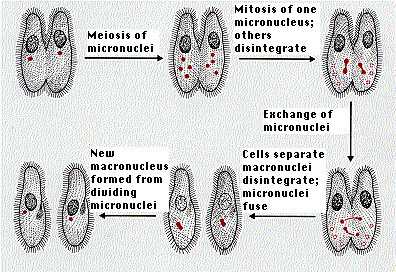Ciliated Protozoans
Although single-celled, there is nothing primitive or simple about these protists.
Not only are they large for single cells (some can be seen by the unaided eye), but they contain organelles that parallel in function the organs of multicellular creatures. In fact, some biologists consider the ciliates to be acellular (not cellular) rather than unicellular in order to emphasize that their "body" is far more elaborate in its organization than any cell out of which multicellular organisms are made.
Ciliates have:
- at least one small, diploid (2n) micronucleus. It contains the entire genome but is not active in gene transcription.
- a large, polyploid macronucleus that contains the active genes that run the cell.
Sexual reproduction in ciliates is by conjugation. The figure shows the process in Paramecium caudatum.

- Two paramecia come together side by side, and a cytoplasmic bridge forms between them.
- The micronucleus of each undergoes meiosis.
- Three of the resulting haploid (n) nuclei disintegrate.
- The fourth duplicates by mitosis.
- One daughter haploid nucleus in each cell moves across the cytoplasmic bridge and fuses with the remaining daughter nucleus in the other cell forming a diploid nucleus in each cell.
- The cells separate.
- The old macronucleus disintegrates and a new one is formed from the micronucleus.
- This process (as seen in the related ciliate, Tetrahymena thermophila):
- The micronucleus produces a copy by mitosis.
- This copy undergoes repeated rounds of endoreplication producing polytene chromosomes.
- Non-genic DNA (like newly-acquired transposons) is removed (by RNA interference).
- The chromosomes are broken up into pieces ("minichromosomes") that often are so small that they contain only a single gene.
- The enzyme telomerase protects these minichromosomes by putting telomeres on their ends.
- The minichromosomes then replicate until as many as 20 million (2 x 107) may be present in the macronucleus.
Two parents come together and two parents separate. What kind of reproduction is that? you may well ask.
But the process they have been through is the very essence of sexual reproduction — genetic recombination. The "offspring" are not the same as the parents. They are new individuals and their macronucleus will soon reflect that fact.
Curiously, though, they have also become identical twins. Each parent formed two identical haploid nuclei — gave one away and kept the other. Thus when the cells separate, their new diploid micronuclei are identical. As the twins begin asexual reproduction (by fission), they are the founders of a clone.
Ciliated protozoans have been the source of several important discoveries in biology, for example:
17 April 2014
